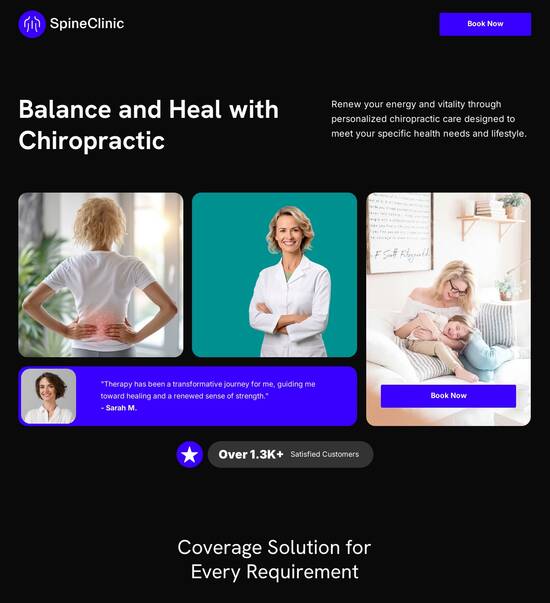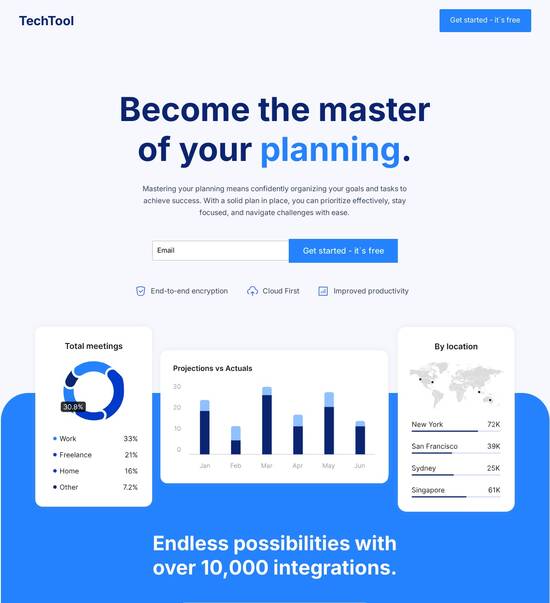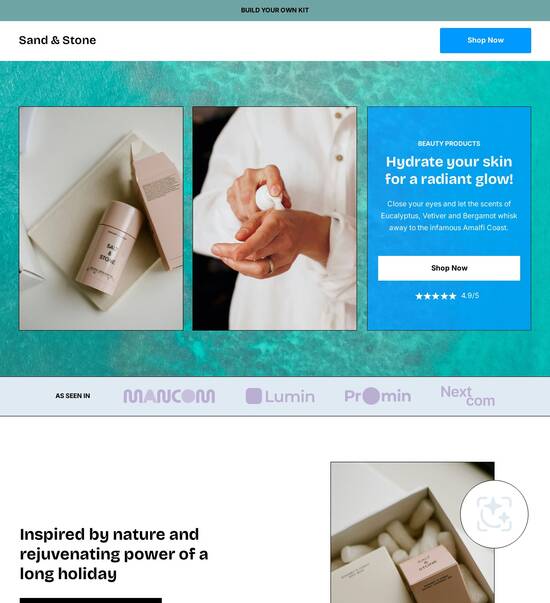
500 internal server error page template optimized for Android
Explore Similar TemplatesAbout template
Customize your Android-optimized 500 internal server error page template for a flawless user experience. Get started now!
Recommended templates

Easy to build without coding
With the intuitive drag-and-drop builder, anyone on your team can create high-converting pages without any knowledge of code or design. Make enhancements to your landing page with custom widgets using Javascript, HTML/CSS, or third-party scripts.

Multiple layouts for any industry and goal
Select from 500+ landing page layouts built to boost conversions across industry-specific scenarios. Customize them by adjusting fonts, adding images, and generating on-brand content with the AI assistant. Quickly scale with Instablocks® and Global Blocks that you can save, reuse, and update globally.

Loads fast and looks polished on any device
Every template is responsive, which means they present professionally on any device and load blazingly fast with our Thor Render Engine. You can also power them up with Google AMP technology to deliver an unparalleled mobile experience and drive higher conversions.

Robust analytics & experimentation
Get real-time updates and reporting across all your devices, showing the number of visitors, conversions, cost-per-visitor, and cost-per-lead. Launch AI-powered experiments, run A/B tests, and use heatmaps to analyze user behavior, then optimize your landing page to maximize conversions.







Easy to build without coding
With the intuitive drag-and-drop builder, anyone on your team can create high-converting pages without any knowledge of code or design. Make enhancements to your landing page with custom widgets using Javascript, HTML/CSS, or third-party scripts.
Multiple layouts for any industry and goal
Select from 500+ landing page layouts built to boost conversions across industry-specific scenarios. Customize them by adjusting fonts, adding images, and generating on-brand content with the AI assistant. Quickly scale with Instablocks® and Global Blocks that you can save, reuse, and update globally.
Loads fast and looks polished on any device
Every template is responsive, which means they present professionally on any device and load blazingly fast with our Thor Render Engine.
Robust analytics & experimentation
Get real-time updates and reporting across all your devices, showing the number of visitors, conversions, cost-per-visitor, and cost-per-lead. Launch AI-powered experiments, run A/B tests, and use heatmaps to analyze user behavior, then optimize your landing page to maximize conversions.
All the features you need to build lead-generating landing pages
Explore more featuresLearn how to build top-performing landing pages for any goal
FAQs
Leading the way in building high-performing landing pages





A comprehensive guide to creating effective landing pages with Instapage
Creating optimized landing pages is crucial for any marketer aiming to boost conversion rates. With Instapage, you can design high-converting pages that resonate with your target audience. This guide will provide a detailed overview of how to leverage Instapage’s features to maximize your campaign effectiveness.
Why choose Instapage for your landing page needs?
Instapage offers an all-in-one solution that caters to businesses of all sizes, making it adaptable to any marketing strategy. Here’s why it stands out:
- Access to over 100 customizable templates: These are designed to capture attention and convert leads efficiently.
- User-friendly drag-and-drop editor: No coding skills are required, allowing marketers to create stunning landing pages in minutes.
- Robust A/B testing capabilities: Instapage lets you experiment with variations, helping identify which elements drive the best results.
Step 1: Setting up your landing page
Begin your journey by choosing from Instapage’s extensive library of templates. Upon selecting a template, you can customize it according to your brand’s aesthetics.
Step 2: Optimizing for conversions
To enhance your landing page's performance, consider the following strategies:
- Implement A/B tests: Regularly test different headlines, images, or calls-to-action to see what resonates with your audience.
- Utilize heatmaps: Analyze user interactions to understand which areas of your page attract attention and which don’t.
- Incorporate personalized content: Tailor your messaging to specific audience segments using dynamic text replacement and AdMaps.
Step 3: Analyzing performance
Once your landing page is live, utilize Instapage's analytics dashboard to track key metrics such as conversion rates and bounce rates. It’s essential to assess the data and make adjustments based on real-time feedback.
- Review analytics regularly: Stay updated on what’s working and what needs improvement.
- Gather user feedback: Consider implementing surveys on your landing page to collect insights from visitors.
- Iterate based on performance data: Keep refining your content and layout to optimize user experience.
In conclusion, utilizing Instapage effectively can significantly enhance your marketing campaigns.
Ready to take your landing pages to the next level? Start your free trial with Instapage today and see the difference for yourself!
People also ask about 500 internal server error page template optimized for Android
500 internal server error page template optimized for android
Understanding the 500 internal server error: A deep dive
A 500 Internal Server Error is a general-purpose error message indicating that there is a problem with the server fulfilling a request. It usually implies the server is aware that it has encountered an unexpected condition but cannot pinpoint it. This error is not something the client can solve; rather, it's a server-side issue that needs attention.
Errors of this nature can stem from a variety of reasons. They may result from server misconfigurations or issues in the server's code, such as faulty scripts or overloading due to immense traffic. Inadequate permissions for files and directories can also lead to this error, making it vital for server administrators to review settings regularly.
Server misconfigurations
Faulty scripts or immense traffic
Database connection issues
The importance of a well-designed error page
When a user encounters a 500 internal server error, the error page serves as their first interaction with your resolution efforts. It's crucial to understand that first impressions matter significantly, as a poorly designed error page can significantly degrade user experience. A seamless, visually appealing error page reassures users that your brand cares about their experience.
A well-designed error page doesn’t just serve to notify users of an issue; it should also guide them during the missteps. By providing clear descriptions and possible next steps, such as links back to the homepage or contact support options, you can encourage users to stay engaged with your site instead of abandoning it. This approach helps maintain brand perception and customer loyalty.
Crafting an optimized 500 internal server error page template for android
Creating an optimized template specifically for Android devices requires attention to several key design principles. It’s critical to ensure your page adopts responsive design principles that allow it to display correctly across a range of Android devices. Utilizing fluid layouts and media queries ensures users can navigate easily, regardless of their screen size.
In addition to responsiveness, visual appeal plays a significant role in branding and communicating professionalism. Incorporating brand elements such as logos and specific color schemes helps reinforce brand identity. Simplicity in design aids in ensuring that users can find the information they need without being overwhelmed.
Responsive design principles
Visual appeal and branding
Essential features of an android-optimized error page
The messaging on your error page is the first piece of communication with a user post-error. It's essential to craft clear and concise messaging that helps users understand that the error is not their fault. Additionally, personalizing your messages can create a better user connection and convey empathy towards their situation.
Incorporating helpful links is another critical feature. Links to the homepage, frequently asked questions, and support options can guide users effectively and reduce frustration. Including a search bar provides users with the option to quickly access the content they're looking for, improving their experience during a frustrating moment.
Descriptive error messaging
Helpful links and navigation
Advancing functionality with innovative technologies
Integrating logs and error tracking into your server management is crucial for troubleshooting and improving performance. Keeping detailed error logs provides data about where issues occur and can guide immediate corrections. Utilizing best practices in collecting and analyzing these logs helps teams to address problems proactively instead of reactively.
Real-time monitoring tools can alert technical teams to server errors as they arise, allowing for swift actions. Many modern technologies offer functionalities that allow teams to access logs efficiently and assess user feedback, which can be invaluable in ensuring continuous improvement.
Importance of detailed error logs
Utilizing real-time monitoring tools
Community engagement and support features
Creating a support community around common error solutions can empower users and expedite recovery from issues. Encouraging user-generated content through Q&A features offers chances for them to connect over shared experiences, facilitating a collaborative solution space that enhances user engagement and trust.
Incorporating comprehensive knowledge bases is another effective strategy. Linking users to in-depth articles and structured FAQs can educate them about your system and reduce confusion during errors. Well-structured FAQs can preemptively answer many questions users might have, thus enhancing user satisfaction.
Building a help community
Incorporating knowledge bases
Interactivity and user engagement
Utilizing interactive tools like previews can enhance understanding for developers and provide transparency to users. Implementing preview features allows teams to display error information before it goes live, ensuring that all elements function correctly across different device resolutions. Regular testing can further help catch issues that might arise due to varying screen sizes.
Smartly alerting users about server issues can also improve their experience. Employing user-friendly alert designs, such as push notifications, informs users of server issues without overwhelming them. Notifications should be concise and emphasize a pathway for users to maintain engagement during technical difficulties.
How previews can enhance understanding
Alerting users smartly
Gathering insights through user interaction
Creating effective feedback mechanisms allows you to collect valuable insights on user experiences with your error pages. Developing systems that enable users to report issues directly from the error page not only aids your team in troubleshooting but also makes users feel involved in the resolution process.
Analyzing user behavior post-error can yield critical data about navigation patterns. Using tools to track how users engage with your site after encountering an error helps identify areas that might require improvement, ensuring a smoother user journey in the future.
Effective feedback mechanisms
Analyzing user behavior post-error
Enhancing the developer experience
Creating an efficient workflow for teams is essential for effective error management. Collaborating across teams fosters synergy and ensures that technical support, design, and marketing efforts are aligned. Utilizing tools that facilitate communication and encourage feedback loops can drastically reduce time wasted in correcting recurring issues.
Documentation plays a vital role in maintaining an efficient workflow. Regularly updating documentation related to error handling allows developers to have quick access to solutions for known issues. Developers can also benefit from collecting insights where they discuss their experiences, lessening learning curves and improving collective performance.
Collaborating across teams
Documentation and knowledge sharing
The future of error handling on mobile platforms
The landscape of error management continues to evolve with emerging technology trends. Artificial intelligence is playing an impactful role in predicting and preventing server errors before they occur, helping create a smoother user experience. Automated systems for crafting personalized error responses can also enhance user satisfaction by addressing inquiries automatically and efficiently.
Innovations in user experience are also on the horizon, with new approaches in enhancing interactions on error pages emerging regularly. Implementing future technologies that simplify error handling will make a notable difference in how users perceive and interact with error messages. Staying current with these trends will position businesses to not only meet user expectations but exceed them.
Artificial intelligence and automation
User experience innovations
Specific case studies and examples
Analyzing success stories from notable brands can provide insights into how effective error page strategies can significantly improve user experience. Brands that have optimized their error pages often showcase strong alignment with users, increasing brand trust and enhancing retention rates. For instance, think about how a well-handled 500 internal server error can turn a potentially negative experience into an opportunity for brand engagement.
User testimonials focusing on error interactions can also shed light on the importance of error handling. By gathering real user experiences, companies can learn about the ways their error strategies are influencing retention. Effective error pages create openings for customer loyalty, helping brands navigate sentiments surrounding service interruptions.
Success stories from notable brands
User testimonials and insights
Ready to skyrocket conversions?
Supercharge your ad campaigns with high-performing landing pages
Get started














